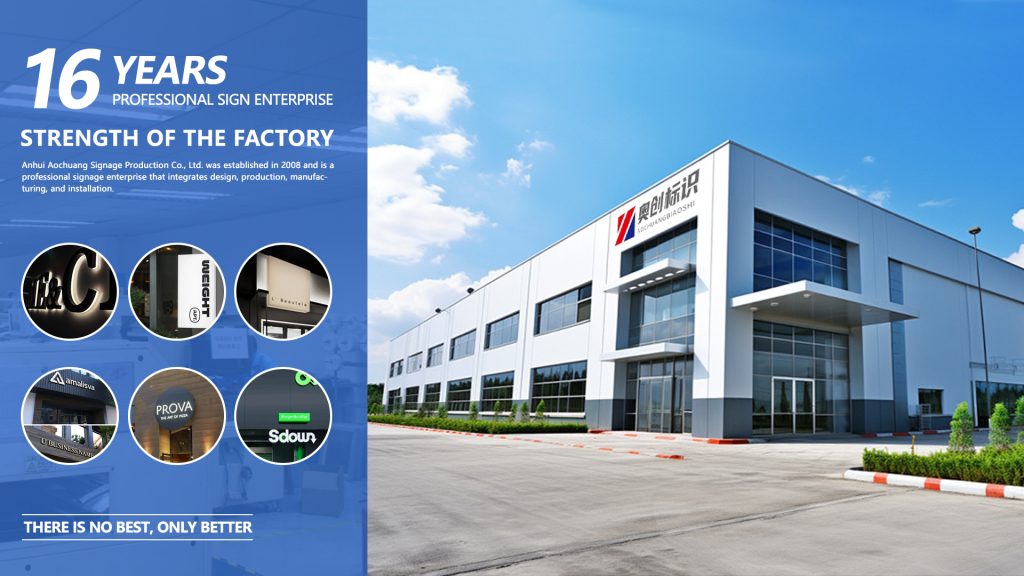Your cart is currently empty!
Outdoor signage: the silent power of urban image and commercial guidance
We can always see various outdoor signals in the streets and alleys of the city, in front of shopping malls, transportation hubs, and other corners. These seemingly ordinary things actually play a crucial role in our lives and business activities.
The functional diversity of outdoor signage
Outdoor signage first and foremost has a powerful function of conveying information. Whether it’s directional signs, signs indicating the names and business scope of shopping malls and stores, or display boards promoting various activities and promotional information, they all convey key information to people in the first place. For example, in large transportation venues such as airports and train stations, clear signage can help passengers quickly find important areas such as waiting halls, ticket counters, and security checkpoints, avoiding getting lost and chaotic, and improving travel efficiency. In the business field, the sign of a store is like a business card of a product, which can attract the attention of passersby, let them understand the nature and characteristics of the store, and guide consumers to enter the store for consumption. For example, some uniquely designed and eye-catching restaurant signs can often attract more diners’ footsteps.
The Charm of Design and Creativity
A good outdoor signage design can not only meet functional needs, but also become a beautiful landscape of the city. Creative outdoor signage can stand out among numerous competitors and leave a deep impression on people. For example, some logos that use clever shapes, unique color combinations, or incorporate local cultural elements are often easier for people to remember. Taking the scenic spot signage of a certain tourist city as an example, its design incorporates local traditional architectural styles and cultural symbols, providing accurate guidance for tourists and serving as a carrier for spreading local culture, allowing tourists to appreciate the beautiful scenery while also feeling the rich local characteristics. Moreover, with the continuous development of technology, the design of outdoor signage has become increasingly diverse. The application of dynamic lighting effects, electronic displays, and other elements makes outdoor signage more vivid and lively, presenting different visual effects at different times and environments, further enhancing its attractiveness and influence.
Selection of materials and processes
Outdoor signage is exposed to natural environments for a long time and needs to withstand various tests such as wind, sun, rain, snow, and freezing. Therefore, the selection of materials and processes is crucial. Common outdoor signage materials include metal, wood, plastic, acrylic, etc. Metal materials such as stainless steel and aluminum alloy have the characteristics of high strength and corrosion resistance, making them suitable for making large-scale signs for long-term use; Wood gives people a natural and friendly feeling, often used in places with cultural heritage or distinctive styles; Plastic and acrylic materials have good weather resistance and plasticity, and can be used to create various shapes and colors of labels. In terms of craftsmanship, the application of techniques such as spraying, carving, and screen printing can ensure clear patterns and long-lasting colors for identification. For example, outdoor advertising images produced using high-quality printing technology have bright and realistic colors that are not easily faded even under prolonged sunlight exposure.
Standardization and Management of Outdoor Signs
In order to ensure the effectiveness and aesthetics of outdoor signage, various regions have introduced a series of relevant regulations and management policies. These specifications involve multiple aspects such as the placement, size, and content review of identification. For example, in the main streets and public areas of the city, there are strict restrictions on the installation of outdoor advertising signs to avoid excessive signs causing visual pollution and safety hazards. At the same time, there are clear requirements for the content of the logo, which must be truthful, accurate, and legal, and must not contain false advertising or misleading information. Through standardized management, outdoor signage can be set up in a more orderly manner, better serving the public and urban development.
Close connection with brand image
For businesses and merchants, outdoor signage is an important component of brand image. A unified, standardized, and recognizable outdoor signage system can strengthen the brand’s impression in the minds of consumers, enhance brand awareness and reputation. For example, some internationally renowned brands use similar logo designs and styles in their stores worldwide, allowing consumers to easily identify them wherever they go, thereby establishing trust and recognition of the brand. Moreover, outdoor signage can be combined with the brand’s advertising strategy, forming a comprehensive brand promotion system through synergy with other media channels, providing strong support for the company’s market expansion and business development.
Outdoor signal, as an indispensable part of urban environment and commercial activities, is contributing to our lives and economic development with its unique charm and value.
